NVIDIA’s GeForce GTX 460: The $200 King
by Ryan Smith on July 11, 2010 11:54 PM EST- Posted in
- GPUs
- GeForce GTX 400
- GeForce GTX 460
- NVIDIA
Overclocking
Last but not least on our tour of the GeForce GTX 460 is a look at the overclocking abilities of the card. As we discussed earlier, NVIDIA is heavily promoting the overclockability of the card to the press, proclaiming that they are regularly able to get most cards up to 800MHz. We’re in a unique situation today to put that to the test, as along with our 2 reference cards, we have an additional 4 vendor cards from our GTX 460 roundup to tinker with. With 6 cards on hand we have a non-definitive but still very useful sample set to work with to verify just how overclockable these cards are, and what kind of a power penalty this entails.
For the purposes of this section we are focusing on the overclockability of the core, but not the memory. NVIDIA’s weaker GDDR5 memory controller coupled with the tendency for memory overclocking to reduce performance through the need to use error detection and retransmission makes memory overclocking much more difficult and often a bust entirely.
As not all of our cards are exactly alike, we’ll quickly run down the differences between the various cards
- 1x NVIDIA GTX 460 768MB Reference
- 1x NVIDIA GTX 460 1GB Reference
- 2x EVGA GTX 460 768MB SuperClocked: Reference PCB and cooler, factory overclocked
- 1x Zotac GTX 460 1GB: Reference-derived PCB, custom blower-style cooler
-
1x Asus ENGTX460 768MB TOP: Custom PCB, custom cooler, factory overclocked, voltage tweak
| Stock Clock | Max Overclock | Stock Voltage | Overclocked Voltage | |
| GTX 460 768MB Reference | 675MHz | 840MHz | 0.987v | N/A |
| GTX 460 1GB Reference | 675MHz | 825MHz | 1.025v | N/A |
| EVGA GTX 460 768MB SuperClocked #1 | 763MHz | 850MHz | 1.000v | N/A |
| EVGA GTX 460 768MB SuperClocked #2 | 763MHz | 840MHz | 0.975v | N/A |
| Zotac GTX 460 1GB | 675MHz | 835MHz | 1.000v | N/A |
| Asus ENGTX460 768MB TOP | 700MHz | 930MHz | 0.975v | 1.062v |
| GTX 460 1GB SLI | 675MHz | 800MHz | N/A | N/A |
| EVGA GTX 460 768MB SuperClocked SLI | 763MHz | 840MHz | N/A | N/A |
Among our 5 cards without voltage tweaking capabilities, all of the cards are closely clustered together in terms of the final stable overclock, with only a 25MHz difference between the top and bottom cards. The 1GB cards ended up with slightly lower overclocks than the 768MB cards, which is likely a product of the 1GB cards containing further enable ROPs and L2 cache than the 768MB cards. Meanwhile the best overclock on a card we got without a voltage tweak was one of our EVGA cards, which was able to go to 850MHz. On average we were able to attain a 24% overclock over the GTX 460 reference clock of 675MHz, and in the case of the EVGA cards a 10% overclock over their factory speed of 763MHz.
The lone standout in the group is the Asus card, which has voltage tweaking capabilities that allow us to increase the core voltage beyond the GPU’s VID. Asus’s SmartDoctor software allows for the card to be overvolted to 1.087v in 0.0125v increments, however in testing we found that anything over 1.062v would ultimately cause the card to fall back to 405MHz, which we believe to be the card’s VRM protection kicking in after the VRMs overheated. At 1.062v we were able to get the card to up 930MHz, a 33% overclock from the factory overclocked speed of 700MHz, and 38% faster than the GTX 460 reference clock of 675MHz.
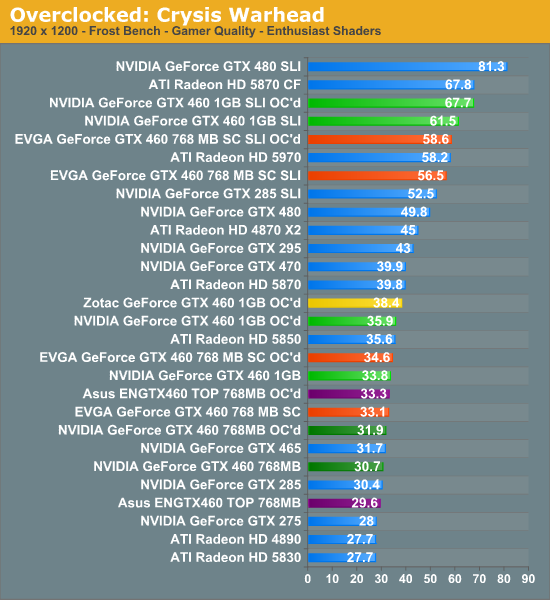

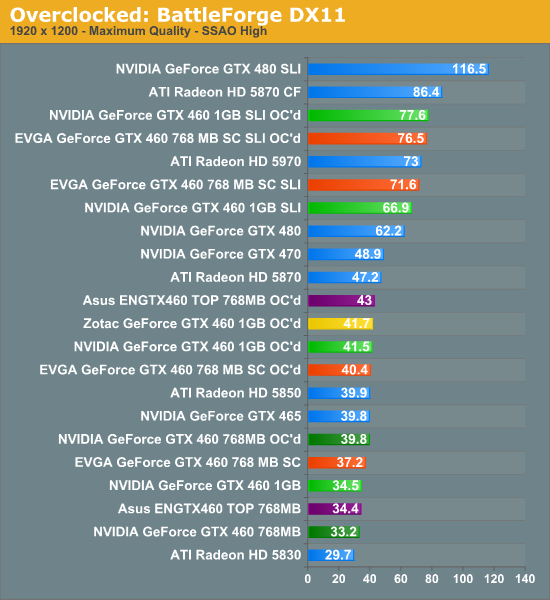
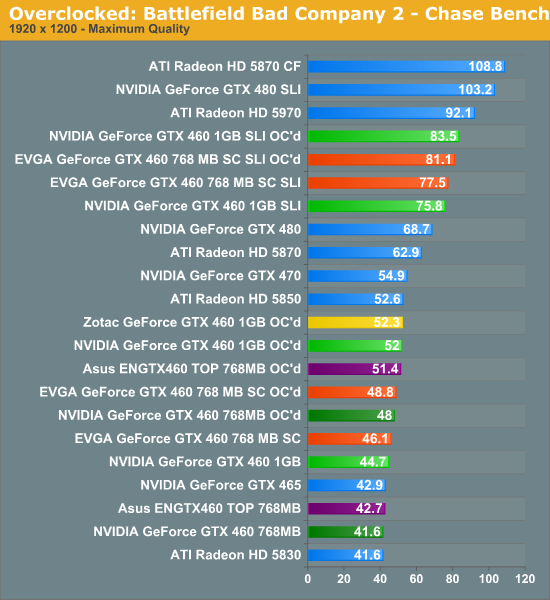
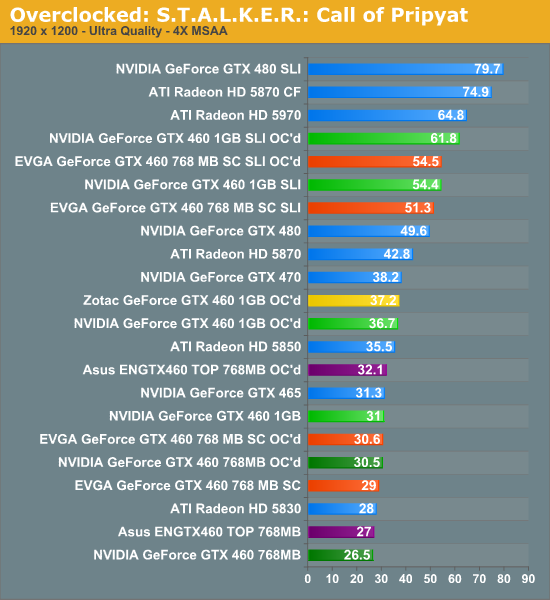
Overall the impact of overclocking is heavily game dependent. Core overclocking favors games that are ROP/shader limited and has little effectiveness on games that are limited by the total available RAM or by memory bandwidth. For this reason out of our subset of games core overclocking was most effective on Battleforge and Bad Company 2, while only moderately effective on Crysis and STALKER. On Crysis and STALKER overclocking was at best only marginally more useful than having a 1GB card. And even with its greater core overclock, the Asus ENGTX260 is not immune to this effect once the 1GB cards are overclocked – it still falls behind an overclocked 1GB card ¾ of the time.
Currently the sweet spot would look to be a 1GB card with a lesser overclock. The additional RAM/L2/ROPs more than makes up for the higher overclocks the 768MB cards can attain in most situations.
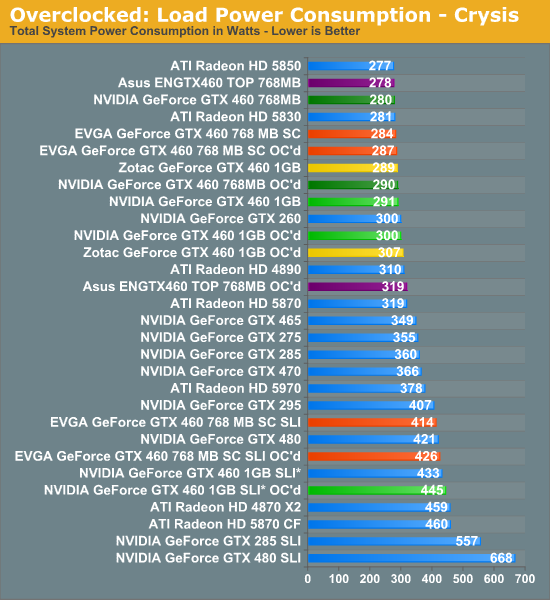
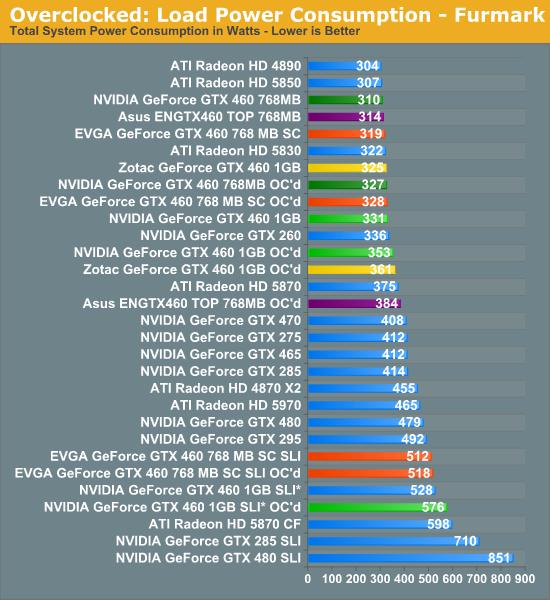
For the cards without voltage tweaking capabilities, the power consumption penalty for overclocking is very minor due to the fact that power consumption increases with voltage much faster than it does with frequency. For the stock-clocked cards this is a 15W-25W penalty, while the factory overclocked cards are even lower (thanks to binning) at just 9W. Meanwhile as expected the Asus card with its voltage tweaking capabilities ends up witnessing a larger jump in power consumption in return for its greater overclock capabilities: 70W.
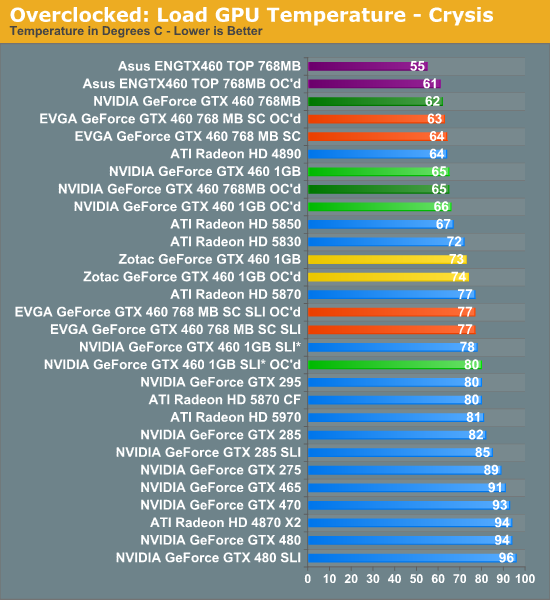
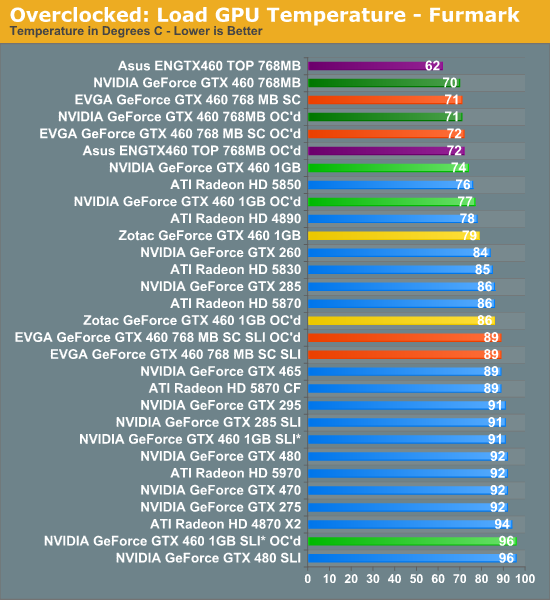
With only a minor increase in power consumption and the use of very efficient coolers, the GTX 460 only experiences a minor rise in temperature when overclocking without voltage modification. All of our cards with the exception of the Zotac under Furmark only rise in temperature by a few degrees, leaving temperatures well in the safe range for these cards. Even the Asus card with voltage modification stays fairly cool thanks to its more aggressive fan, rising by up to 10C under Furmark but still only becoming as warm as our stock-cooled cards in the first place.
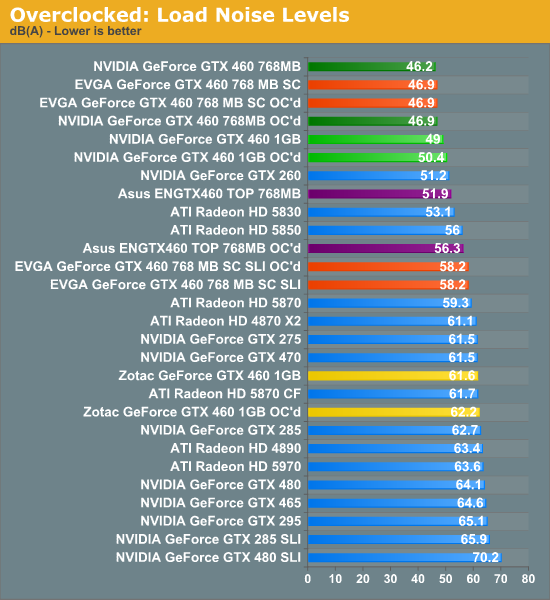
Last but not least we have the noise factor. Thanks to the very low increase in power consumption these cards experience when overclocking, the coolers on these cards have to do very little to handle the extra heat. For the cards without voltage modding, the amount of noise generated increased by less than 1.5dB, and in the case of our EVGA cards didn’t increase at all. This results in our GTX 460 cards remaining as some of the quietest mid and high-end cards we’ve ever benchmarked, even with a 24% overclock.
The Asus card is of course the exception to the rule here, once again due to a combination of the more aggressive cooler and voltage modification. Here the amount of noise generated shoots up by 4.4dB when overclocked, which is a fair trade for the overclock but is definitely going to be more noticeable than the rest of the cards in our collection.
With all of this taken in to consideration, there’s little we can do to argue with NVIDIA’s claims about the GTX 460’s overclocking capabilities. One thing we need to make clear before going any further though is this: overclocking is not guaranteed. In our briefings with NVIDIA, they have told us that they know not every GTX 460 can hit 800MHz+, which in turn is part of the reason why the stock clock is only 675MHz. We believe a majority of cards will be strong overclockers, but this cannot be applied to all cards. Buying a GTX 460 is still going to rely on the luck of the draw, only the odds are very good at the moment. So if you absolutely must have an overclocked card, then a factory overclocked card is still the way to go.
At this point if you do receive a strong card it makes little sense not to overclock thanks to the very small increase in power consumption (and as a result, temperatures and noise) that overclocking causes. This is as close to as free of an overclock as there can be for a video card, so run with it and enjoy performance approaching a Radeon HD 5850.
Finally, if you are going to overclock, what kind of a card should you be shooting for? As it turns out the reference cooler does a very good job of hitting a balance between cooling needs and noise, while Zotec’s cooler does worse and Asus’s cooler does better at a cost of additional noise. We will add that we believe that overclocked 1GB cards are a better way to go just like we believe that 1GB cards are the way to go when at stock clocks, but ultimately this becomes a matter of affordability.










93 Comments
View All Comments
medi01 - Tuesday, July 13, 2010 - link
It was like that some day. But now I see more and more troubling signs. iPhone dissapearing from comparison photos ("oh, I've forgotten, it should have been in my pocket") when it has huge disadvantage, but always shown where it has advantage. (and happy readers crowd not "noticing" such "unimportant detail")AMD's 5830, the 200$ card with the same "it's slower than older... but it has some features" got serious beating right in the title. (guess what, it was actually cooler than older cards, so it had one advantage more than that of nVidia). On the other hand nVidia's 200$ card that is EXACTLY in the same positoin, got PRAISED in the title.
How on earth could that be called neutral?
ViRGE - Tuesday, July 13, 2010 - link
The 5830 launched at $240, not $200. In that respect the GTX 460 is not only launching at that cheaper price, but it's faster than the 5830 (and the 4890 the 5830 failed to beat).maxpain12 - Friday, September 17, 2010 - link
I agree with Lonyo, they are simply pointing out the technical aspects of the silicon. It gives those that follow the latest and greatest developments in chip architecture some food for thought. It was never intended to mislead a customer, the performance numbers are enough evidence to give the customer a decent understanding of what to expect in the real world application of the chip in consideration.Quidam67 - Saturday, July 17, 2010 - link
You're being a bit a of a fan-boy in my opinion. The article is very well balanced. Seriously, the 460 is the first good card from nVidia in a long time, and at a genuinely afordable price. ATI finally have some real competition on their hands. Up till now they have owned this generation. And the 5830 was always an odd fit for that market sector. Really, it was just an afterthought on how to repurpose 5870 rejects. It filled a hole, but now that hole doesn't exist anymore. It's the one ATI card from this generation that I really didn't like.Zendax - Saturday, July 31, 2010 - link
When the 5830 was released there was no current generation competition, so the only point of comparison was the past generation of cards.With the 465 the obvious points of comparison are the 5830 and 5850.
I'm not going to say, resolutely, that there's zero bias, but you're clearly LOOKING for an nVidia bias, and when you go about it that way, you're guaranteed to find it.
Goty - Monday, July 12, 2010 - link
... meh.It's a decent card, but it's still months too late.
notext - Monday, July 12, 2010 - link
I agree. It is good but AMD could easily drop the 5850 down to the 1gb prices and the advantage is gone. Hopefully they will.Quidam67 - Saturday, July 17, 2010 - link
That's what I hope will happen, because at the moment my next card is going to be a GTX 460 unless the 5850 price drops a littleDominionSeraph - Monday, July 12, 2010 - link
Not all of us scour rumor sites and wait with bated breath for months for the next big thing to come out. For some of us, waiting a few months is no big deal. (especially with the lack of any "must-have" gaming titles. The heyday of PC gaming is long over.)Since the launch-price 5850's (which didn't last long), the GTX 460 seems to be the first really good buy out there. The 5770 didn't outperform the 4870, the 5830 was an overpriced turd, the price-gouged 5850's and 5870's aren't good price/performance bargains, the GTX 470 and 480 are no better and are power hogs to boot.
THIS has me excited -- especially the SLI scaling. $400-$460 in cards that'll often beat a $700 5970? And they have low idle power consumption and decent load consumption (for the performance)? I mean in that price range is the 5870, GTX 480, and 4870 x2, and GTX 460 SLI beats them all. The 5870 has much lower load power consumption going for it but it's also significantly slower.
Unless you're going to need the power of 5870 in CF, the GTX 460 seems to be the way to go.
Rekdurexu - Monday, July 12, 2010 - link
"For everything but the high-end, this year is a feature yet and not a performance year."Is that "yet" supposed to be year?